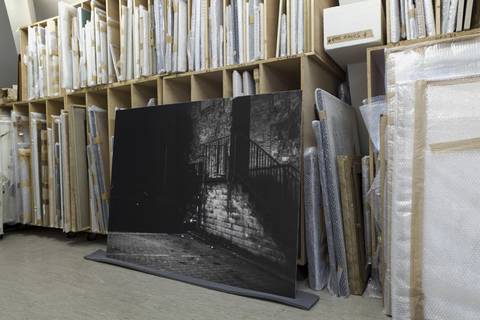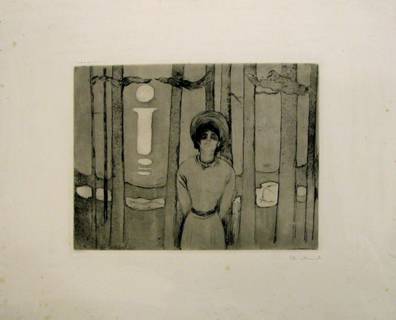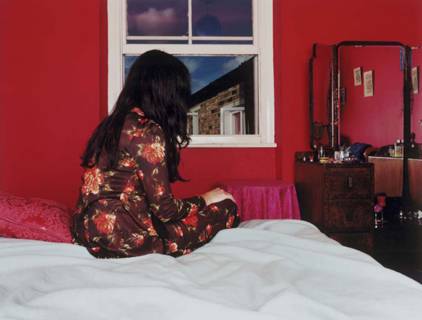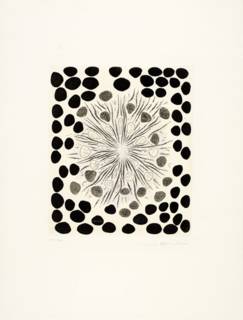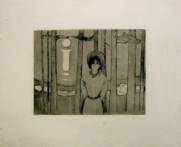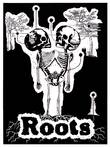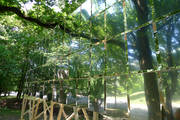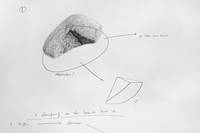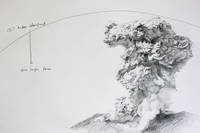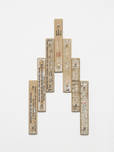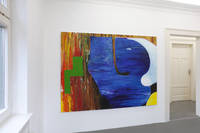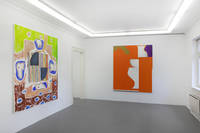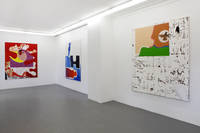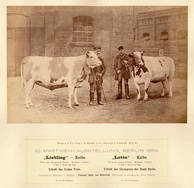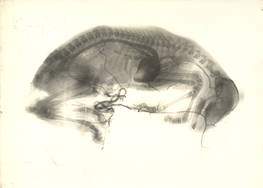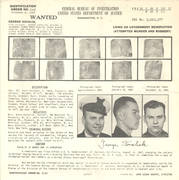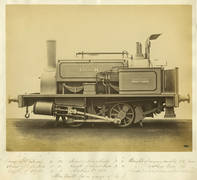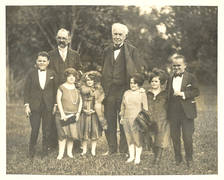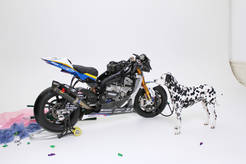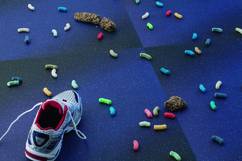12 October 2014 – 11 January 2015
Obsessions and Surreal Worlds
Works from the Prints Collection of the City of Esslingen am Neckar
Bahnwärterhaus
Opening: Sunday, 12 October 2014, 11 am
Bringing the subconscious onto paper and designing ambiguous, surreal pictorial worlds: The Galleries of the City of Esslingen present in the Bahnwärterhaus a cross-section of drawings, prints, and photographs from the Prints Collection of the City of Esslingen am Neckar. Right up to today, the artistic investigation of reality sometimes crosses over into the realm of the surreal or the obsessive.
The exhibition probes the fantastical worlds situated between reality and dream. Whether irrational or mystical, obsessive or dreamy, neurotic or provocative—the artistic attitudes are due to pointed approaches. Works from the twentieth century, e.g. by Hans Bellmer, Lovis Corinth or Wols, come into relation with current positions of international contemporary art such as those of Damien Deroubaix, Michael Bauer, or Melanie Smith.
The range of artistic languages extends from the uncanniness of true-to-life situations all the way to obsessive distortions of human impressions.
In particular, the acquisitions from recent years provide the show with unexpected insights into the municipal Prints Collection. Unknown treasures of the 20th and 21st centuries from the Prints Collection come to light. The exhibition continues a series of presentations from the collection such as “Volker Böhringer: Industriegrafiken” (2006), “Das alles auf Papier!” (2007), “kein licht für wen” (2008), and “Heribert Friedland. Tuschen und Aquarell im Dialog mit Werken der Graphischen Sammlung der Stadt Esslingen am Neckar” (2008).
Curated by Andreas Baur and Tina Plokarz
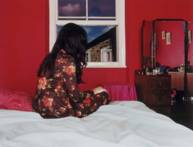
Sarah Jones<br/>The Bedroom, 2002<br/>C-Type-Print on aluminium, 130 x 170 cm<br/>Graphische Sammlung der Stadt Esslingen am Neckar
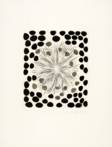
Meret Oppenheim<br/>Steine - Schwarze Tropfen, 1974<br/>Etching on 250g Arches paper, 66 x 50 cm<br/>Graphische Sammlung der Stadt Esslingen am Neckar
29 June 2014 – 21 September 2014
Andreas Schulze
Opening: Sunday, 29 June 2014, 11 am
Andreas Schulze develops his thoroughly independent painterly attitude during the nineteen-eighties and continues to give it a distinctive profile today. He initially works in the Cologne circles of the Mülheimer Freiheit and the so-called Junge Wilden. But early on, he distances himself from their expressive, spontaneous, and subjective style. He occupies a unique position in the painting of contemporary art.
The solo exhibition at the Villa Merkel in Esslingen will be divided conceptually into two parts. For the ground floor of the Villa Merkel, Andreas Schulze is developing a large-format spatial installation and is “furnishing” this level of the former residential building with painterly interventions. As with all of the artist's interventions, themes from his paintings will be expanded in the exhibition space. Found objects are included along with his own sculptures and lamps. Factual and fictional spaces thereby become interwoven. Complex relationships are established between everyday objects and ornamental décor, between unconventional lifestyle and bourgeois normality. Andreas Schulze's melancholic landscapes and interiors convey both coziness and menace; they take up the themes of society's striving after security and comfort and of the alienation inherent to the “private” aspect, in which the bourgeois need for harmony turns out to be narrow and restrictive. And this artist always gets down to business with a characteristic wink and profound humor.
Gunter Reski writes: “The painting of Andreas Schulze supposedly has a lot to do with naïve charm. It comes along with an astounding nonchalance.
Andreas Schulze is probably one of the few artists who are capable of painting with an amused shrug of the shoulders. Quite simple and quite easygoing. A little like cheerful puberty on the way toward abstraction, or like a tipsy return from there back toward home... Already during his student days, Andreas Schulze magically pulled his ultimate style out of a hat, and since then he has simply remained true to it. Enchanting, abstract simplifications of the everyday world which do not feel obligated to bring into play either metaphysical superstructures or substructures in visual representation. I mistakenly considered him to be simply the world's best painter of peas... Depictions of human beings do not occur. There are hints of living spaces whose core has been neatly removed, à la broken-home stories, whose non-represented inhabitants perhaps evince a similar number of handicaps and blank spaces, so that one prefers not to show them at all. On the other hand, Mars candy bars, fruit, cobblestones, solariums, tableware, and all sorts of jauntily shaded, geometric, fundamental forms populate his tasteful, spherical progressions of color in the background... The radical simplicity of these pictorial settings continues to be refreshing. Schulze's liberating spoof of what is ultimately a clerical reductionism, not only from America, possesses the strength that his fundamental tomfoolery does not run aground in the shallow channels of parody or charade. Hard to say how he manages to achieve this feat.”
The exhibition will travel in modified form to the Kunstmuseum Bonn, and then to the Kunstmuseum St. Gallen.

Andreas Schulze<br/>Installationsansicht bei Sprüth Magers London, 2009<br/>Andreas Schulze / Team Gallery, New York / Sprüth Magers, Berlin/London
Debut exhibition at the Bahnwärterhaus
3 May 2014 – 15 June 2014
Byun Chul Kim – Von Oma bis Nietzsche
Opening: Friday, 2 May 2014, 7 pm
Closing: Sunday, 15 June 2014, 11 am
Byung Chul Kim draws. In his new, to some extent large-format works, he visualizes stories and thoughts. These are philosophically subtle drawings. The finesse in the graphic execution corresponds to the refinement of the represented thoughts. At the same time, the minutely and meticulously elaborated drawings stand in direct contrast to the furious pace of fashions and trends.
The viewer can gaze in protracted amazement, can grow contemplative in the reflective response to what is offered to view. With a great deal of humor and ingenuity, Byung Chul Kim opens up a space filled with fantasy and with occasionally strange intellectual games.
Images and concomitant textual notations become intertwined in the storyboard-like drawings in
a self-evident manner. Parables appear in altered form: With pictures and through pictures, the artist tells a story, or he ushers into view a thought which opens up slowly and thus has an all-the-more extended impact.
Byung Chul Kim, born in South Korea, first studied at the ChuGye University of the Arts in Seoul before completing his art studies from 2002 to 2011 at the Staatliche Akademie der Bildenden Künste in Stuttgart with a concentration on sculpture and new media under the supervision of Christian Jankowski.
The exhibition has been realized in collaboration with the Staatliche Akademie der Bildenden Künste Stuttgart.
In cooperation with

9 March 2014 – 8 June 2014
HAMISH FULTON – WALKING TRANSFORMATION
Opening: Sunday, 9 March 2014, 11 am
Hamish Fulton, an artist born in 1946 in London, works on an utterly independent oeuvre. It is extremely poetical and bears witness to a distinct, authentic, and cosmopolitan attitude.
For more than forty years now, Hamish Fulton has been transferring the act of moving on foot into an art form―namely the Walks. He creates works of art while walking. He undertakes Walks on all the continents of the Earth, for instance “From Coast to Coast” across the islands of Great Britain. Hamish Fulton transforms the experiences he has during these journeys. On the basis of drawings and photographs collected during the Walks, he designs wall drawings, murals, photographs, texts, and also objects. They may be read as universally valid artistic forms which concentrate the diverse manifestations of the original and immediate relationships of human beings to the Earth, but at the same time they may be understood as a passive protest against urban societies which alienate humanity from nature. “No Walk, No Art” – with this congenial and uncompromising formulation, Hamish Fulton describes his method of working.
He considers the Walk itself already to be a work of art. It arises between the poles of tension and relaxation, concentration and distraction, exertion and recuperation, experience and knowledge. Hamish Fulton seeks insights, not outlooks. For him, the act of walking is also a form of ascertainment with regard to his own person. Thus the artist challenges himself with new tasks during each Walk.
One time he walks for days through Scotland with meditative serenity, another time he pushes his body to its utmost limits in the Himalayas for weeks on end, and yet another time he counts with the precision of a land surveyor each step taken over the course of a day: On October 10, 1991 during a Walk around the Hiei Mountain in Japan, he takes 33,210 steps in a peregrination which he later translates into a dense graphic picture consisting of that exact number of points.
During his precisely planned and choreographed Walks, each with a specific theme, the artist shares his multifaceted experiences directly with his audience. In the Japanese city of Kitakyushu during the year 1994, Hamish Fulton actively included further persons in his works for the first time. Since then, many persons throughout the world have participated in a large number of Group Walks which explore the world and connect diverse cultures.
The exhibition in Esslingen is being preceded by Walks in India. They will constitute the nucleus of the exhibition, complemented by a few works from earlier Actions. Far more than a half of the works featured at the exhibition in Esslingen will have been newly created for this occasion.
(Cf. Laudation by Freddy Langer: "If in doubt, keep walking. A walk with Hamish Fulton ", Berg.Welten, 2010)

Hamish Fulton<br/>Himalaya Snow Mountains, 2012<br/>Wandbild<br/>Courtesy Hamish Fulton / Häusler Contemporary München Zürich
Debut exhibition at the Bahnwärterhaus
9 March 2014 – 21 April 2014
Sascha Patzig
Tod Jenseits Auferstehung (Liebe)
In his new cycle of pictures “Death Beyond Resurrection (Love),” the painter and electrician Sascha Patzig, born in 1979 in Freiberg/Saxony, does not refrain from expressing a sensitivity which explores the moods and changes in our consciousness.
He demonstrates a capability for using painterly quotations to situate the phenomena of an undeniable artistic heritage in a new context and, in spite of a nimble irony, he does not refrain from following existential-moral impulses. The project investigates the relationships between painting to consciousness in general and to a specific pictorial knowledge.
Preview: Friday, 7 March 2014, 7 pm
Opening: Sunday, 9 March 2014, 11 am
The insistent individuality of the richly associative visual ideas, along with the reduction to a strategy of coloration, gives content to form and simultaneously gives form to content. This series of pictures endeavors to distill the aesthetic essence of painting by creating painterly voids.
Through this manner of proceeding, the painter voices his respect for painting in its purest form.
The debut exhibition is being realized in collaboration with the Staatliche Akademie der Bildenden Künste Stuttgart.
In cooperation with

15 December 2013 – 16 February 2014
Wozu Bilder?
Gebrauchsweisen der Fotografie
Opening: Sunday, 15 December 2013, 11 am
“What Use Are Pictures?” – especially in today's times, this is a downright radical and simultaneously impertinent question. The same-named exhibition takes as its theme the extremely varied utilizations of photography on the basis of some four hundred photographs from a renowned private collection in southern Germany which are outstanding, even bizarre, sometimes strange, but always astounding.
“Bringing the world home”; “Remembrance”; “Classification”; “Documentation”; “Arousal” – these are a few of the topoi which group examples of historical photography into contentually related picture-tableaus.
“What Use Are Pictures? Utilizations of Photography” at the Villa Merkel turns the customary perspective back onto the medium. The exhibited works have not been selected according to what may be seen upon them or what subjects they offer, but instead with a view to their forms of utilization and application, which are brought to light across a broad spectrum. There are such uses, for instance, as that with the help of photography, nature can be investigated or romanticized, people may be called to mind or traced by the police. Entertaining items may be found under the heading “Jokes.”
These are pictures which cause amusement, induce laughter. They already existed long before the invention of photography. But only photography makes it possible (through montage, multiple lighting, etc.) to allow a lady to engage in a game of chess with herself. Photography has the capacity for making the impossible seem credible …
The exhibition and publication was developed over the course of a two-semester project at the Universität Konstanz in winter 2012/13 and summer 2013 under the supervision of the instructors Bernd Stiegler and Felix Thürlmann.
The exhibition and publication Wozu Bilder? Gebrauchsweisen der Fotografie is receiving generous financial support from the Innovationsfonds Kunst of the State of Baden-Württemberg and, in the context of the initiative of excellence of the Federal Republic and the Federal States, from the cluster of excellence Kulturelle Grundlagen von Integration of the Universität Konstanz.

Fotograf unbekannt<br/>Zwei japanische Damen, um 1880<br/>Kolorierter Albumin-Abzug<br/>26 x 20,8 cm<br/>Privatsammlung
Supported by Innovationsfond Kunst
15 December 2013 – 16 February 2014
Stefan Panhans
Schnee schnell Schnee Du bleiches Reh
Opening: Sunday, 15 December 2013, 11 am
In filmic works, photographs, and installations, Stefan Panhans (*1967) develops pictorial worlds oscillating between documentation and artificiality. Articles from the world of urban consumption such as brand-name gym shoes, fitness equipment, and granola mixtures serve as props in photographic still lifes or are parts of a meticulously prepared décor for film sets. Moving in these scenarios are mask-like, artificial figures that seem to have lost their way between lifestyle, self-optimization, and media hype.
The videos of Stefan Panhans are shot in a single take and do not adhere to a narrative logic. The concentration is upon a pictorial language and carefully staged monologues and dialogues. There is frequent use of sampling techniques which take up advertising slogans, slang expressions, or marketing language. In the video “ Sieben bis Zehn Millionen” (“Seven to Ten Million”), for example, a person describes at breakneck speed the complications which can arise when purchasing technical equipment. Only upon a second look does the face of the speaking man, wrapped in a fashionable hood with fur collar, reveal itself to be that of a woman. The viewer himself is manipulated in ambivalent images which conceal several layers behind their superficially shining advertising optics.
The video “Sorry” has almost no language at all. It takes place in the overcrowded pullman car of an intercity express train. People shove their way past each other and climb over heaps of gaudily colored luggage. An everyday image in a second-class carriage of the German Railway—if it were not the case that every person is wearing an exaggerated costume inspired by a role model from the world of art and media. Things which seem to have no affinity with each other are fitted together into an opulent image of our era.
The photographs as well are unexpected stagings of contemporary lifestyle and a persiflage on the mechanisms of advertising photography. For the exhibition at the Villa Merkel, a series of photographs have been newly produced and are being presented for the first time.
In addition, the exhibition at the Villa Merkel features several video works. In the framework of the exhibition, a section of the Villa Merkel itself serves as the setting for a new video by Stefan Panhans. The setting will remain in place while the newly-produced video is presented at the Haus am Waldsee in Berlin, starting on January 19, 2014.
Stefan Panhans lives and works in Berlin and Hamburg.
Solo Exhibitions (Selection):
2014 “Too much Change is not enough,” Haus am Waldsee, Berlin; 2013 “The Long Goodbye (Pre-Afterwork-Ok-Clubset) Casino,” Project in a Public Space, Steintorplatz, Hamburg; “Untitled & Items for Possible Video Sets - FW Run / SORRY Homestory,” FELDBUSCHWIESNER, Berlin; 2012 “Stefan Panhans - Untitled & Items for Possible Videosets - Concrete Run,” 'Art is Concrete. And so is Truth?', Camera Austria / Steirischer Herbst, Kunsthaus Graz; 2011 “Wann kommt eigentlich der Mond raus?”, Museum für Gegenwartskunst, Siegen
Group Exhibitions (Selection):
2013 “Utopien vermeiden,” Werkleitz Biennale, Halle (Saale); “FORMER WEST, Notes from Berlin,” BAK, basis voor actuele Kunst, Utrecht; “HIS MASTER’S VOICE: Von Stimme und Sprache,” Medienkunstverein Dortmund; “FORMER WEST: Documentations, Constellations, Prospects,” Haus der Kulturen der Welt, Berlin; “In was bin ich da reingerutscht? Existenz und Identität in der Kunst,” Kunsthalle zu Kiel; 2012 “Keine Zeit – Erschöpftes Selbst/ Entgrenztes Können,” Belvedere 21er Haus, Vienna; “Uncanny Home,” Corridor, Reykjavik; “Über die Dinge,” Kulturstiftung Schloss Agathenburg; 2011 “Von der Sehnsucht nach Glanz und Gloria,” (Videoscreening), Museum Ludwig /ISEA2011I Istanbul; “Schon wieder und noch mal – Handlungsspielräume?”, Kunstverein Medienturm, Graz; “Schlaf und Traum. Für eine Praxis des Horizontalen,” Shedhalle, Zürich
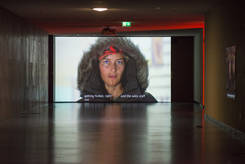
Stefan Panhans<br/>Sieben bis Zehn Millionen, 2005<br/>HDV, 16:9, Farbe, Ton, 5:30 Min.<br/>Installationsansicht „Former West: Documents, Constellations, Prospects“, Haus der Kulturen der Welt, Berlin<br/>Foto: Marcus Lieberenz<br/>Stefan Panhans / Feldbuschwiesner, Berlin / Galerie Dorothea Schlueter, Hamburg
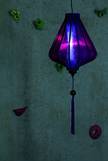
Stefan Panhans<br/>Items for Possible Video Sets #27, 2011<br/>C-Print, 80 x 53 cm<br/>Stefan Panhans / Feldbuschwiesner, Berlin / Galerie Dorothea Schlueter, Hamburg
Kindly supported by

